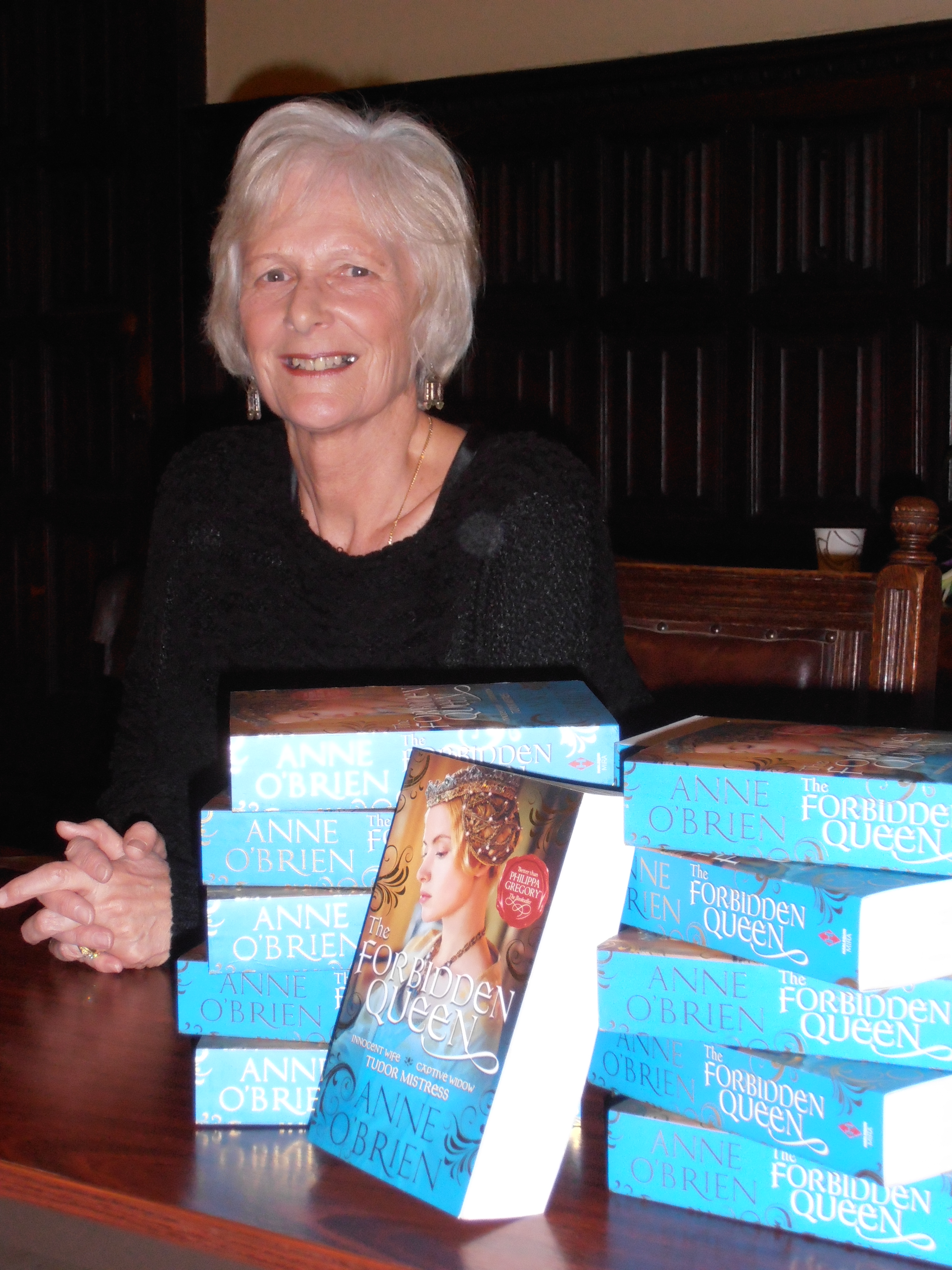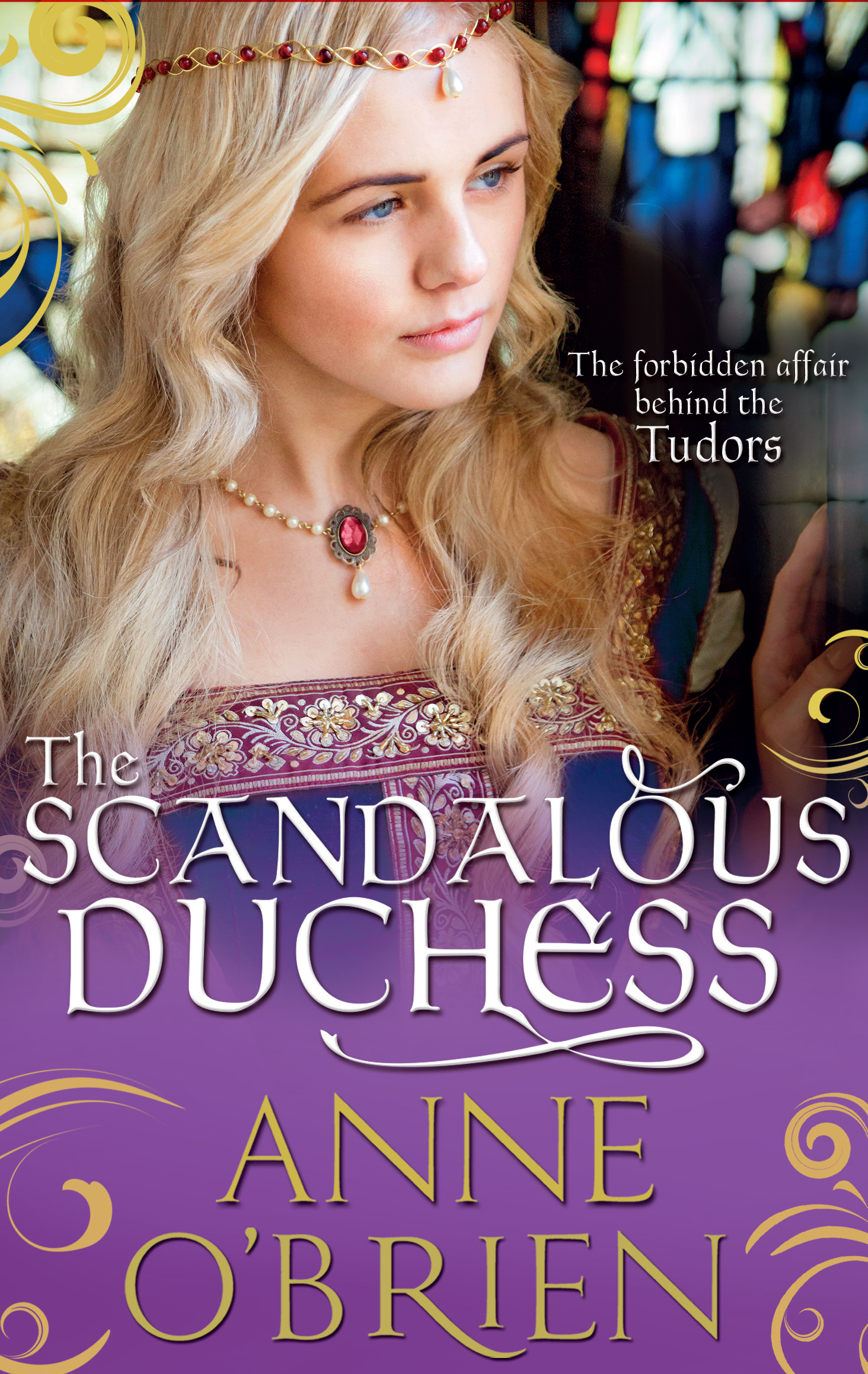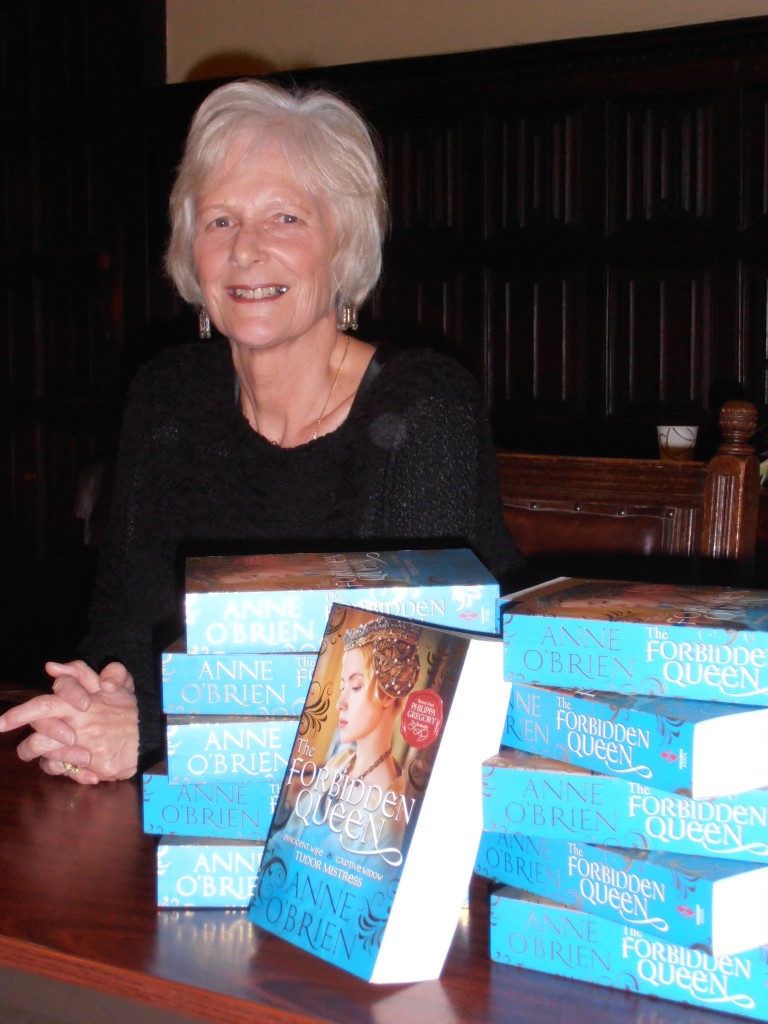Our “Talking To” post this week is also a competition give away. Read on and find out how you could win a copy of Anne O’Brien’s latest novel, The Scandalous Duchess, published today!
By Karen Sayers

I was first introduced to Anne O’Brien’s historical fiction by Fiona Gell. I already enjoyed reading medieval novels, so discovering Anne’s work was fantastic. Fiona lent me Devil’s Consort, Anne’s gripping account of Eleanor of Aquitaine’s tumultuous and adventurous life. Last June I was lucky enough to meet Anne at The Leeds Big Bookend Festival. Her talk was fascinating. Afterwards she encouraged me to put pen to paper. I’ve now written a few scenes and, who knows, thanks to Anne may one day progress to a novel! Recently I asked Anne a few questions about her books, methods, and next project.
There’s a great contrast between Eleanor of Aquitaine’s overt strength of character in Devil’s Consort and Anne Neville’s quiet determination in Virgin Widow. How do you choose the leading ladies for your books?
I think it is more true to say that my leading ladies choose me. Here are my priorities. She must have something to say about the time in which she lives, the stronger the better although that is not of primary importance. Katherine de Valois was certainly not a strong character. My heroine must be either ambitious in her own right, such as Eleanor of Aquitaine or Alice Perrers, or acting under the influence of the political affairs of the day, such as Anne Neville and Katherine de Valois.
Then there are the personal elements. It is even more important that there are emotional demands on my heroine’s life, created by her own character, family or English policy. There must be an element of conflict to heighten tension, all the better if it is between hero and heroine. She need not always be good, not always admirable. We can be free to be critical, but ultimately we need to be able to empathise with her choices and how her character develops. We have to live the heroine’s life with her, both highs and lows of it.
If these elements of conflict, danger and fulfilment, of joy and heartbreak, are not present, it does not work. I would love to write about Philippa of Lancaster, Queen of Portugal, but she is simply too good: an excellent wife, loving mother, impressive queen. A heroine needs drama!
Does your research include visiting the locations your characters would have inhabited? If so can you give an example?
This is one of the real pleasures; visiting the haunts of these medieval women to gain insight into their lives. It is like stepping back into their time, as much as we are able, to follow their footsteps where they walked and lived. The solid structure of Middleham Castle, a true medieval stronghold, shows me the environment of Anne Neville, full of brooding northern power. Kenilworth Castle is a splendid window into the world of Katherine Swynford with the remains of Duke John’s extensive building of a private wing for feasting and dancing.
Leeds castle in its perfect setting develops the romance of Katherine de Valois with Owen Tudor. Whether she ever had a bathing room such as we can see there I have no idea, but it all adds to the glamour. Sadly the manors owned by Alice Perrers along the Thames no longer exist. I would love to be able to absorb her ambience as the remarkable businesswoman she became. And of course, what a tragedy that The Savoy Palace, the London home of John of Gaunt and his family, was destroyed in the Peasants’ Revolt. We have to make the most of what we have. A visit to the Tower of London is always a spine-tingling pleasure.
How do you decide which historical events to include in your novels?
The events I include are dictated by writing in the first person. They must be experienced by a heroine who has emotional involvement in them. The events must have a direct bearing on the heroine’s story and her development as a character. If she is not involved, then any extraneous events fail to carry the plot forward, and become a mere historical ‘bolt on’. On the other hand there has to be sufficient historical ‘background’ to give the plot the correct flavour and show the heroine in her setting. It all has to be carefully balanced without overloading the novel with facts. (I am not big on scenery or the weather either.)
Facts can be researched from history books if I whet my readers’ appetite. I write about relationships within history, and as I write novels, they must have a page-turning quality. So for example the war against France had no influence on the life of Katherine de Valois, other than the fact of her marriage. She showed no interest in her disinherited brother, the Dauphin. The whole story of Joan of Arc was played out in the background of Katherine’s life but it is not relevant to her story. It can be very dangerous if authors are too self-indulgent. The plot can easily be swamped with ‘history.’
In the preview chapter of your latest novel, The Scandalous Duchess you create a strong tension between John of Gaunt and Katherine Swynford. How do you get inside your characters’ minds?
It helps when historical evidence is kind enough to leave clues, such as the character of the Duke. He was supremely self-confident, ambitious with a leaning towards arrogance – how would he not be as a Plantagenet prince? He had a temper. He could be sensitive enough to make loyal friends, but could be intolerant, making bitter enemies, although he was politically astute enough to mend fences when he had to. He could be surprisingly emotional, but coldly calculating when the need arose. This is the Duke’s historical character and is therefore set in stone for the novelist. I must work with it. Whatever it was that Katherine saw in him made her love stronger than all the difficulties they faced, all the strains of adultery on their affair.
Katherine presents a different problem because she comes to us as a very shadowy character: no diaries, no letters, remarkably little contemporary comment and what there is, is on the whole, critical. So what do we have? She was a pious, respectable widow, employed as governess to the Lancaster children. What drove such a woman to risk her immortal soul in an adulterous relationship that lasted many years, under the nose of the Duke’s second wife, Constanza of Castile? I try to think as Katherine might have done. How would she react to the very public rejection of her by the Duke in 1381. How would she feel, being labelled whore and witch? As any woman would, I think. This combination of historical events, and my reading of her very female response to her shocking position in the Lancaster household, has to be the basis for Katherine’s character.
Their affair was certainly no light hearted romance, all the evidence points to it being stormy as well as passionate. Within this interpretation, Katherine and The Duke must work well together as lovers. It has to be a realistic relationship with all its joys and travails, and I cannot believe that Katherine was merely a romantic cipher.
Which male character you’ve written about did you find most fascinating? Would you ever write a novel with a male central character?
I would have to say, which has come as a surprise to me, that John of Gaunt is the most fascinating. He developed into the most complex, the most unpredictable, the most edgy of heroes, and in some ways the most difficult to write about because his character is not an easy one. The reader has to feel empathy with him, because Katherine loved him, but he was not always well loved in his day, and this must be included. It was important that I revealed the conflicting sides to John’s character, yet we must still admire him and see him with love through Katherine’s eyes. I hope I have achieved it. I think so, because I have come to admire him.
Who to write about? If I am ever tempted to abandon medieval women, I would be strongly inclined to take on Richard Neville, Earl of Warwick, named The Kingmaker. Now there’s a complex character! I think he would cast even John of Lancaster into the shade. One day, perhaps…
Your books appeal to a wide 21st century audience. Do you have specific techniques for adapting story lines to suit contemporary readers?
I am not sure that I do adapt too much. It is true that the women I write about lived under more restrictive influences and beliefs than women today. They had far less independence, bound by religion, morality and duty to family, yet their emotions and aspirations are not dissimilar to those of their 21st century sisters. Evidence shows that they yearned for love. Some of them, such as Eleanor, were driven by ambition to wield power, or cushion their lives against an uncertain future, a strong motive for Alice Perrers. Some like Katherine de Valois simply wanted contentment.
I think 21st century readers will recognise their medieval counterparts. They enjoy the historical setting, and readily connect with the emotions that touched the lives of my leading ladies. My heroines certainly suffered from the same range of emotions: jealousy, resentment, delight, grief, fear and uncertainty, a determination and will to overcome adversity. Not all are successful of course, but at least they were not forced to take refuge in a convent.
I use a light hand when dealing with some of the strong religious and moral tenets of medieval England. They cannot be omitted, because they are the bedrock of a heroine’s life, but it is not my place or that of my characters to preach. A 21st century audience, I believe, has no wish to be swamped with morality.
What is your next project?
I am writing about Elizabeth of Lancaster, younger daughter of John of Gaunt and the beautiful Blanche of Lancaster. I first stumbled across her when visiting the tiny rural church at Burford in Shropshire – she has a magnificent tomb there – and again when writing The Scandalous Duchess. History has not always been kind to Elizabeth, either ignoring her in favour of her more famous siblings Henry IV and Philippa who became Queen of Portugal, or by describing her as a woman no better than she should be – ‘frankly wanton and highly-sexed.’
There is so much more to Elizabeth than her marital adventures – she was married three times – being one of the powerful Plantagenet family. Governed by duty but seduced by a man of great charm if dubious character, she was torn apart by family loyalties and ultimate betrayal in the overthrow of Richard II. A lively young woman, gifted and precocious, she was forced to choose between husband and brother, thus experiencing both the joys and pain of the political battles of the late 14th century. Elizabeth provides us with a splendid heroine, and John Holland, Duke of Exeter, is a troubled but compulsive hero.
What better characters for an historical novel? Elizabeth and John are keeping me very busy at the moment.
Is historical fiction something that you plan to stay with, or do you ever want to venture into another genre?
I have no plans to abandon historical fiction. It is a genre in which I feel comfortably at home. Characters in medieval history fascinate me. Where is it possible to find more enthralling stories? The relationships between medieval characters are dynamic, full of heartbreak and intense joy, driving ambition and the despair of absolute failure, as well as love requited and rejected (much like today, really). It is powerful, heady stuff to write, and, I hope, to read.
After saying that, I might switch historical periods. After watching Desperate Romantics on BBC2 last year, I was gripped by the glamour and vitality of the nineteenth century Pre-Raphaelite painters. I have always loved their dramatic paintings but the people fascinated me, leading flamboyantly talented, if often desolate, lives with their wives and mistresses. I am certain there is a novel in the world of Dante Gabriel Rossetti and friends.

Anne O’Brien’s latest novel, The Scandalous Duchess is published today. For a chance to win a copy of this breathtaking story of the relationship between Katherine Swynford and John, Duke of Lancaster, simply answer this question:
Who was the daughter of Katherine and John, who chose to be buried beside her mother in Lincoln Cathedral?
Please email your answer to Anne by pasting the link into your browser, http://www.anneobrienbooks.com/contact/ and filling in the form or click here.
The deadline for entries is midnight on Friday 14th March 2014. Anne will notify the winner and let everybody know via Facebook and Twitter.
Good luck!

